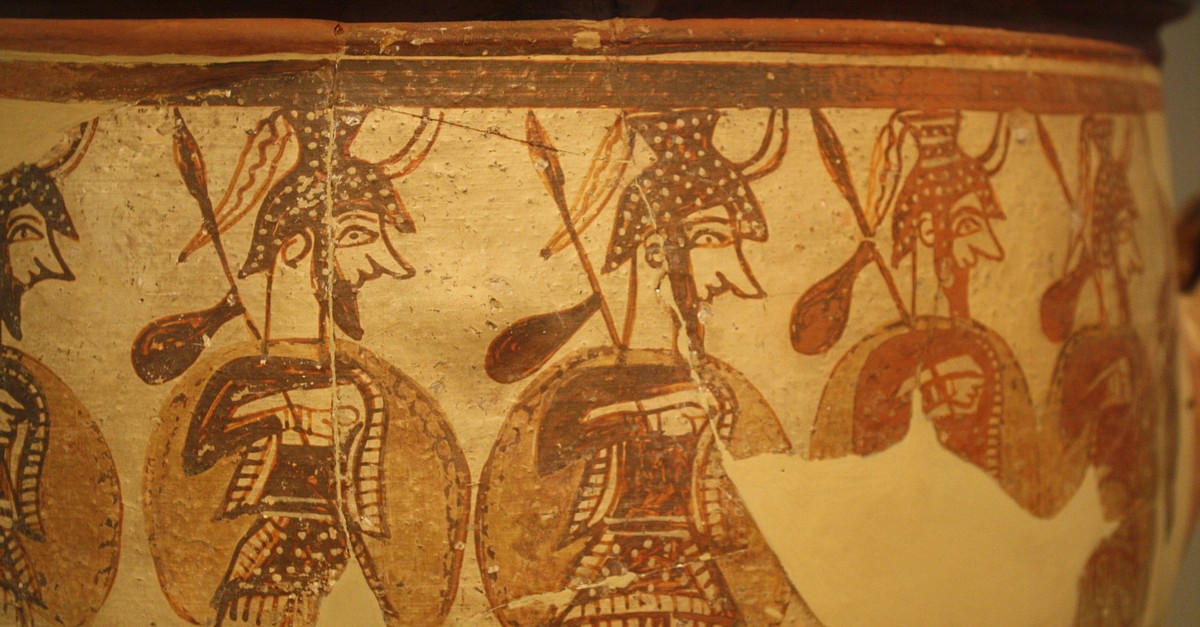

Until recently, there was no way to know whether it was imported or not, all statements being suppositional. The meaning, of course, is "Cycladic pottery like Minoan pottery." It does not help to hypothesize that the Akrotiri Minoan pottery is imported.

Anything found at Akrotiri is Cycladic, not Minoan.
WARLIKE MYCENAEAN ART CODE
The code per se does not allow for cross-assemblages that is, artefacts that turn up in more than one defined area, such as Minoan pottery at Akrotiri. There is not much likelihood that the conventions of the major archaeologists will be redefined, so to speak, by rogue art historians. In the code, the very core of "Helladic" is Mycenae and Pylos in the Peloponnesus. Individual art historians writing books often attempt to redefine the terms for their own works for example, there has been a relatively current attempt to redefine "Helladic" by removing Peloponnesus from it and placing it in a supposed "Aegean" category, entirely ad hoc. He can propose for consideration typically, most proposals are not adopted. One archaeologist cannot arbitrarily change the convention. The code has been institutionalized by such organizations as the British and American Schools at Athens. It was then up to the archaeologists to match these layers to layers in the code. Islands such as Cyprus and Rhodes, not in any of the three code areas, were allowed their own systems, such as Cypriote I, Cypriote II, etc. "Minoan" must mean Crete, and Cycladic must mean in the Cyclades there are no exceptions. "Helladic" must refer to a site on the mainland. For example, LH IIIA2 means "Late Helladic, subperiod III, subperiod A, subperiod 2." There would always have to be at least two subperiods at each level, i.e., there cannot be a IIIA without at least a IIIB. Subsequently, by convention, following Evans, the layers were grouped and numbered: E, M, L for early, middle, and late, Roman numerals for the subdivision of each one of those, capital letters still further down, Arabic numerals, small letters, and after that if necessary descriptive terms. The Cyclades are a specific number of islands in the Aegean Sea. Subsequently, Carl Blegen, excavator of Pylos, who found the main cache of Linear B tablets on his legendary first day's dig, extended Evans' system to "Helladic" (adjective of Hellas, abbreviation H) and "Cycladic" (adjective of Cyclades, abbreviation C).

He also chose Minoan for the name of the civilization. Arthur Evans, excavator of Knossos and a friend of Schliemann's, followed this custom at Knossos however, foreseeing that the layers there would likely be repeated elsewhere, he preferred the name "Minoan" (abbreviation M) over Knossos, as he believed that one of the high kings of Crete ruling from Knossos was the legendary King Minos. He identified cities layered on top of one another: the first, the second, etc., starting at the bottom of the heap. The custom of naming layers began with Heinrich Schliemann's excavations at Troy. Pottery is an especially good diagnostic of time period when found within a layer. Predetermined knowledge of the layer provides information about the time and other circumstances of the artefacts found within it.

Typically an archaeological name identifies the site and the relative position of the layer. Archaeology depends on the fact that layers of types of soil and content accumulate over time, which undisturbed, can yield information about the various times. An archaeological name is the name given to a layer (or layers) at a site that is being professionally excavated. This code had been standardized by various archaeological conventions. The term "Mycenaean" has been imposed upon a matrix of abbreviational archaeological names, which amount to an archaeological code. 2.4.3 Other types known from archaeologyĪrchaeology and Mycenaean pottery Definitions The archaeological code.1.2.2 In search of the Mycenaean horizon.1.2 History of the concept of ceramic Mycenaeans.


 0 kommentar(er)
0 kommentar(er)
